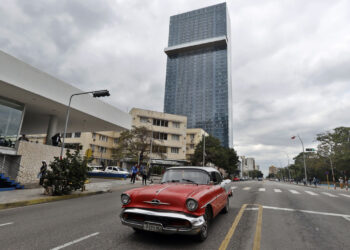In 2010 an experimental model of management in Havana was launched from which a Taxi Agency was created where cars serving in convertible pesos (CUC) were leased to CUBATAXI drivers.
Since then the relations between the state agency and the driver (by the later becoming self-employed and stop being in the payroll) began to be regulated by a contract where it is included a set of conditions to be met by both parties , Débora Canela Piña, specialist of the Ministry of Transport ( MITRANS ) explained to Granma newspaper.
“Given the positive results of the first Agency , and as part of ongoing monitoring and improvement of the experience , in 2011 the Agency # 2 in Havana and in 2012 the Agency No. 3 in Varadero were created ” the specialist said. After a period of study and adjustment of the designed mechanisms the Gazette Extraordinary No. 1 this year, today publishes a set of standards with which the process of generalization of this experience begins.
” This is part of the broader process of transformation that takes place in the management of many services today and the purpose is that before the end of 2014 the experience gets extended across the country taking into account the characteristics of each territory ” she said .
Thus the implementation of Guideline 278 approved by the Sixth Congress of the Communist Party of Cuba continues to advance, in which the promotion of new forms of management in the transportation of passengers and cargo is promoted, as well as other services associated with the activity.
“More than a change in the image of vehicles, the new design is part of the implementation of a management model with impact on business structures, administrative workers employed in them, and the drivers themselves, with the aim essential to increase the quality with which today these services are offered,” she explained.
The decision to extend this form of management aims also at solving a set of problems that currently characterizes the CUBATAXI Business Group, whose traditional system has not been able to solve; misappropriation of the collection ; irregularities in services, excessive staffing with inadequate balance of direct and indirect employees , and a fleet of aged vehicles . All of them are realities that over the years have resulted in a loss of quality in these services.
On the results achieved so far by the three agencies operating taxis, she said that in them they have been able to substantially increase productivity. Furthermore, “significantly reduces the waiting time of customers after requesting the service and the obligation to use the meter or official rates is maintained.”
You need to note that under this system, the drivers assume, with his income, maintenance costs, fuel and payment of vehicle repairs, while they may keep them and perform all the “runs ” of their own choosing paying taxes depending on their income.
EXTENDING THE BENEFITS
“For the creation of the agencies in the country we will create the Cuba Taxis Company to which all the assets that are required will be transferred from existing entities. A total of 20 agencies will be opened based on the fundamental principles already applied in the three existing and all will be subordinated to that enterprise. Both this and the agencies will have a minimum of state workers to which an additional payment in correspondence with the results of performing the work they do “she said.
– What other features includes this form of management?
– The agencies also have the opportunity to lease premises for providing transport-related services as is the case of fixing flat tires, scrubbing, mechanical repairs, and other services.
“Subsequently, these agencies may incorporate people owning their vehicles, provided they meet the technical and comfort established for this type of service,” she added.
Also, “all associated drivers , owning or leasing cars may qualify for transportation requests made by legal persons, including tour operators and travel agencies , service that until now has been exclusive to the state sector .”
– What requirements must be met by vehicles to join this program?
– First, it is important to note that in the case of state-owned vehicles we will recover 60% of the fleet with cars that come from the income of the tourism sector, the rest operate from a selection among currently circulating in country. In this sense, as more cars are received, we gradually continue the replacements.
” All means of transport are incorporated into the new system will start a cycle of sheet metal , painting and labeling; then they will be repaired , parts and accessories replaced and they will be maintained . Then they will be entered in the Registry of Vehicles, pass automotive technical inspection and finally will receive the identification attachments for taxi service.
“Cars you can see today parked in different parts of the country are moving through the various stages of this process.”
Moreover, she also stressed that the “regular taxi service offered in Cuban pesos (CUP) in clinics, hospitals and funeral will remain providing their services as of today.”
It is therefore to adjust gradually every single detail without pretending that the generalization of the experience becomes a straitjacket with identical shades for all provinces. This is just another step in the middle of the diverse and complex transformations that is taking place in each of the areas of Transportation.
Taken from CubaDebate










